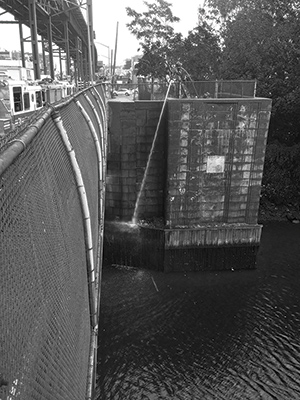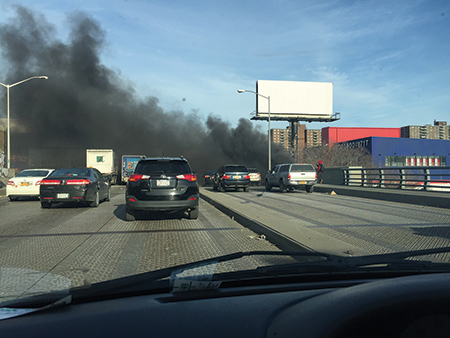By Daniel P. Sheridan
We received a call ONE DAY at around 1700 hours from one of our Fire Department of New York (FDNY) members who was just getting off shift. He advised us that there was a fire under the bridge that traverses the Bronx River on Interstate 278 (The Bruckner Expressway), a major artery connecting the Bronx with the rest of New England. We get rubbish fires all the time in such places-usually people trying to burn the plastic off wires to sell the copper as scrap. It didn’t sound like a big deal. I was about to notify the dispatcher when the tones went off. The Bronx borough dispatcher was sending us the box assignment: one engine, one ladder, a fireboat, and the battalion chief.
 |
| (1) A previous incident involving a rubbish fire on a bridge bulkhead had been routine. (Photos by author.) |
As we left quarters, I didn’t give the call much thought-probably nothing more than a minor rubbish fire near the water. We had a similar call not too long ago, and it wasn’t much more than a part of the wooden bulkhead burning (photo 1). My only concern was whether the 500-gallon booster tank would be adequate to address the rubbish fire. This was probably going to be more of a nuisance than anything else. We had a similar fire recently, and our biggest headache was gaining access to get water on the fire. I was happy to see that the fireboat was responding because that would solve our water problem.
 |
| (2) However, approaching the scene, it seemed that this would not be a routine call. The blue building is the self-storage business. |
As we turned the corner to get onto the road that leads to the expressway, I realized that this was more than a simple rubbish fire (photo 2).
I did a COAL WAS WEALTH size-up:
Construction: concrete and steel.
Occupancy: drug den (known from previous responses).
Apparatus/equipment: one engine, one ladder, one fireboat, and the battalion chief.
Life: possible squatters.
Water supply: no hydrants.
Area: under the bridge, approximately 2,000 square feet.
Street conditions: rush hour traffic.
Weather: very cold-20°F.
Exposures: the bridge.
Auxiliary appliances: a standpipe in a storage facility.
Location: under the bridge.
Time: rush hour.
Height: not applicable.
Initial Size-Up
On arrival, we transmitted the signal for a working fire to give us a full first alarm assignment. We were confronted with a whole host of problems as follows:
- There was a heavy fire condition under the bridge.
- We were unable to stop traffic on a major highway, so cars were continuously traversing the bridge, thus creating a “live load.”
- Additional units were having difficulty approaching the scene.
- There were no hydrants, and drafting was not an option because of the lack of access to the river.
- A fireboat was still 15 minutes away.
- There was spalling of concrete and exposed steel.
I developed a strategy built around protecting the steel on the bridge. My main concerns were to initiate a primary search to ascertain if there were any homeless people trapped underneath the bridge while at the same time getting water on the steel to keep it cool. According to Francis L. Brannigan’s Building Construction for the Fire Service, Third Edition:
- Steel starts to elongate at 1,000°F.
- If the steel meets resistance, it will then buckle or overturn.
- When heated to higher temperatures (above 1,300°F), the yield point of steel is drastically reduced, and it may fail and bring about total collapse.
- Steel is a good conductor of heat.
My concern was with the live load of still-moving traffic, which meant a potential disaster when coupled with the possibility of compromised steel. Keeping the fire away and cooling the steel became critical. It was especially important to see the big picture. If we had treated this as an annoying rubbish fire, we might have had to confront some unforeseen problems. The key is to always ask, “What is the worst-case scenario?” and plan your strategy around that.
 |
| (3) Corrugated steel blocked access to the fire. This photo shows the area where the fire occurred; it was a large area of rubbish underneath the highway, not the bulkhead itself this time. |
Critical Issues
In such situations, identify and deal with the most critical issues first. For example, break it down as follows, according to FDNY Deputy Chief (Ret.) Vincent Dunn’s 11-point strategy: 1. Locate the fire; 2. Save life; 3. Prevent fire spread; 4. Confine the fire; 5. Ventilate; 6. Extinguish the fire; 7. Search for victims; 8. Overhaul; 9. Salvage; 10. Prevent rekindle; and 11. Secure the scene.
At this incident, I focused on preventing the fire from heating the steel and concrete. The “all-hands” was transmitted, and we turned our attention to the water problem. The second-in engine arrived, and the officer took charge of the water supply. The nearest hydrant was hundreds of feet away, and the fireboat still wasn’t on scene. The first engine was using booster water (500 gallons) to get some water on the fire, but that wasn’t going to be enough. The stretch was very difficult as well (photo 3).
Other units arrived and were assigned. The ladder companies were assigned ventilation and search. The rescue and the squad used thermal imaging cameras to monitor the temperature of the steel. The rest of the engine companies assisted with the long hose stretch and getting water to the first engine company apparatus. At some point, I heard those magical words, “Engine 96 to Engine 96 officer, I have a positive water source.” That was a relief!
 |
| (4) Accessing the standpipe of a nearby self-storage business enabled firefighters to get water quickly. |
We were now making great progress and knocked down the fire. Although we still had a heavy smoke condition, the bridge’s steel was now out of danger. The ladder companies finished their searches. No one was found under the bridge, so whoever had set the fire was able to get out. The rescue and squad both reported no problems with the steel. We did have some concrete spalling but nothing too serious. We wrapped it up, and companies started taking up. The second engine relieved the first and washed down all remaining pockets of fire. The fireboat had arrived but wasn’t needed, so its crew took up.
We had contacted the New York City Department of Transportation earlier. A representative came to the scene and determined there was no damage to the bridge.
How They Did It
After things settled down, I asked the engine officer about his water supply. I was amazed at how quickly it had been sorted out. I praised personnel on a good stop. I am not sure if many of the firefighters fully understood what was at stake here. The lieutenant told me, “Corey worked it out.” I asked him to elaborate. He explained how Engineer Corey West had gotten water from the self-storage structure’s standpipe system.
I was not surprised. I was captain of Engine 96 for a little while in 2005; it is an excellent fire company that drills frequently. I spoke to Captain Brian O’Connor about the fire. He told me that they had been drilling recently on alternative water sources because of the recent cold snap. One of the contingencies they prepared for was a frozen hydrant. Their solution: Find a building with a standpipe and use the system to supply the engine. Engine 96 has numerous standpipe-equipped buildings in its area.
I asked West about the response. He explained how he gave the company booster water then tracked down the maintenance worker from the self-storage place and had him open the door. Right behind the door was the first-floor outlet to the standpipe. He stretched a 3½-inch supply line and used the necessary fittings to supply the engine (photo 4).
This incident was a great example of why we train-you never know what may come your way. We need to be ready for every possibility. Engine 96 had anticipated and trained for a situation in which there would be no positive water source. The company didn’t even have to give it much thought-it was part of standard operating procedures. Training gives us an opportunity to create memory slides-the chance to be able to react to a situation that is not the norm. Whether it’s stretching a foam line or performing a lifesaving roof rope rescue, training will reinforce that muscle memory.
DANIEL P. SHERIDAN is a 29-year veteran of and a battalion chief with the Fire Department of New York. He is a national instructor and the founder and chief operating officer of Mutual Aid Americas, an international nonprofit training group to assist firefighters. Previously, he instructed at the Rockland County (NY) Fire Academy. He is a frequent contributor to Fire Engineering and has a monthly column on FireEngineering.com. He authored Chapter 12 (Forcible Entry) for the Fire Engineering Handbook for Firefighter I and II.
Fire Service Techniques: Water Supply : The Great Debate
How to Ensure Your Water Supply
Managing the Urban Water Supply

